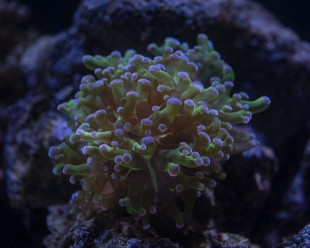Frogspawn coral
Frogspawn coral is a Large Polyp Stony coral which grows quickly in a branch-like manner. The color variation extends from fluorescent green and yellow to other lighter colors such as white or pinks. The coral received its name due to their polyps that resemble frog eggs. Their scientific name is taken from having polyps which are divided at the ends.
Range & Habitat
Frogspawn coral’s range is extended to the central Indo-Pacific, Australia, South-east Asia, southern Japan island and the East China Sea, the Solomon Islands and Fuji. The species is prominently found in depths of 2 to 35 meters.
Conservation Status: Near Threatened
Threats: Globally, the species is threatened by climate change, extremity of water temperatures, ocean acidification, increased severity of El Nino-Southern Oscillation events. Additionally, the species is threated by aesthetic collection of rare coral species in the aquarium wildlife trade.
Diet
In the wild: The symbiotic algae zooxanthellae hosted within the corals’ body produces the majority of required nutrients via photosynthesis. During the nocturnal hours, Frogspawns’ sweeper tentacles extend around 6 to 8 inches in search for nearby food, such as micro-plankton or other small creatures.
In Human Care: Proper lighting for successful photosynthesis. As supplemental nutrition, krill, brine shrimp and other smaller items can be fed to them.
Life Span
Fun Facts about the Frogspawn coral
- Frogspawn corals form coral colonies with corallite walls, and their polyps are able to completely retract into the skeleton. Standardly, their polyps extend during the day and partially during the night.
- Frogspawn is known to be socially aggressive to nearby corals, and their sweeper tentacles can be a threat to other corals as they possess a dangerous stinging ability.
- Almost all members of the genus Euphyllia have a commensal shrimp species associated with them.
Sources
Carrie McBirney., C.M. & Clarice Brough., C.B. Frogspawn Coral. Animal-World+ PET AND ANIMAL INFORMATION. Frogspawn Coral, Euphyllia divisa, LPS Coral Information and Coral Pictures (animal-world.com)
Turak, E., Sheppard, C. & Wood, E. 2008. Euphyllia divisa. The IUCN Red List of Threatened Species 2008: Euphyllia divisa (iucnredlist.org) Downloaded on 17 July 2021.


